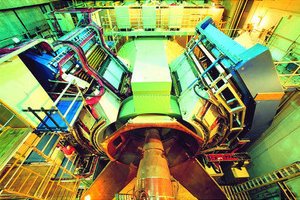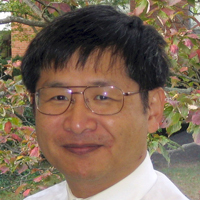Sep. 28, 2007 Research Highlight Physics / Astronomy
Fires of creation probed by quarks
PHENIX detector spots melting particles
 Figure 1: The PHENIX detector at the Relativistic Heavy Ion Collider (RHIC) at Brookhaven National Laboratory (BNL). Image courtesy of Brookhaven National Laboratory
Figure 1: The PHENIX detector at the Relativistic Heavy Ion Collider (RHIC) at Brookhaven National Laboratory (BNL). Image courtesy of Brookhaven National Laboratory
Scientists have confirmed that a powerful particle accelerator has recreated the intense conditions that existed just microseconds after the beginning of the universe. The experiments have also revealed a surprise about quarks, the fundamental building blocks of every atomic nucleus.
The protons and neutrons inside atoms are made from trios of quarks, which are normally held together by gluons. But immediately after the big bang, these nuclear ingredients existed as a hot quark–gluon plasma (QGP). Understanding how this soup condenses into the discrete particles that make up ordinary matter can help to reveal how the subatomic world works.
In order to generate and investigate quarks of various flavors—known by names such as ‘charm’ or ‘strange’—the Relativistic Heavy Ion Collider (RHIC) at the Brookhaven National Laboratory (BNL) in Upton, US, smashes particles together at almost the speed of light. Previous results from RHIC had indicated that a very hot, dense form of matter, was formed in such collisions between gold atoms. But was it a QGP?
To find out, the scientists conducted a series of experiments in 2004/5 to create and study an unusual particle called J/ψ, made up of a charm quark paired with its opposite number, the anticharm quark.
The theory that describes how quarks behave, called quantum chromodynamics (QCD), suggests that the J/ψ particle might melt away in a hot QGP. If the gold–gold collisions had indeed created such a primordial state, the yield of J/ψ from the experiments should be suppressed by melting.
However, QCD is notoriously difficult to solve, and there is still much debate about what temperature J/ψ will melt at—hence the need for experimental investigation.
Hot stuff
The scientists first smashed beams of protons together, and watched what happened using the PHENIX (Pioneering High Energy Nuclear Interaction eXperiment) detector1 (Fig. 1).
J/ψ particles themselves only survive for an instant before they decay into a spray of other particles: either an electron–positron pair, or a muon–antimuon pair. Once PHENIX spots these particles, scientists can work out exactly how original J/ψ particles behaved based on their trajectory and energy.
The team saw thousands of J/ψ particle decays, and since proton collisions are not energetic enough to create a QGP, this established the ‘normal’ level of J/ψ production one would expect from a collision.
“The proton–proton data provides a crucial baseline for the gold–gold measurement,” explains Yasuyuki Akiba of RIKEN’s Nishina Center, Wako, part of the PHENIX team. “And the proton–proton data are interesting in their own right,” he adds. “They can test the theoretical models of J/ψ production.”
When the team switched protons for gold atoms, the heavier missiles created more intense explosions (Vid. 1). They saw that, as expected, some of the J/ψ particles from the initial collision were melting away, lowering their overall numbers2. “This supports the theoretical prediction that J/ψ will melt in a QGP, and thus provides strong evidence for QGP formation at RHIC,” says Akiba.
Quark surprise
Surprisingly, the scientists also found that the central, hotter region of the collision actually hosted more J/ψ particles than the cooler outskirts.
“In the naïve models, the suppression should be stronger in the central region,” says Akiba. That’s because the hottest part of the fireball should melt more of the J/ψ particles.
So the extra J/ψ particles suggests that charm and anticharm quarks produced at the heart of the collision could be recombining into J/ψ, boosting its yields compared to the cooler outskirts of the collision.
“The data is not inconsistent with a very intriguing possibility that J/ψ can be formed in recombination,” adds Akiba, “but, at present, the data cannot rule out other possibilities.”
Elliptic flow
The researchers have now just finished collecting a new set of data on gold–gold collisions which will allow them to measure J/ψ production much more precisely, and perhaps pin down whether this recombination is taking place.
They hope to track the characteristic motion of J/ψ particles produced by recombination of quarks, dubbed ‘elliptic flow’. This should allow them to distinguish between the swirl of particles created by recombination, and the longer-lived J/ψ particles that had simply failed to melt in the QGP and thus would show no elliptic flow.
“Elliptic flow is the name for the collective motion of particle observed at RHIC,” says Akiba. “This flow is generated in the evolution of the dense matter produced at RHIC, and therefore one can get the properties of matter from the pattern of elliptic flow.”
“If all of [the] J/ψ particles that we observe at RHIC are those that survived the melting effect of the QGP, the elliptic flow strength of J/ψ should be very small,” predicts Akiba. “On the other hand, if a significant fraction of [the] J/ψ particles is produced by regeneration, we should observe a strong elliptic flow of J/ψ. We have just started the data analysis looking for the elliptic flow of J/ψ particles in the new data set,” he adds.
Another experiment, planned to start in November 2007, will smash gold atoms into deuterons, a heavy form of hydrogen that consists of a proton and neutron bound together. While no QGP is expected to form in the collision, it should reveal the influence of gold atoms themselves on J/ψ suppression.
Calculating the balance between melting and recombination effects on J/ψ particles should reveal more about the primordial QGP, effectively providing our best glimpse into the hot foundry of creation at the beginning of the universe.
References
- 1. Adare, A., Afanasiev, S., Aidala, C., Ajitanand, N.N., Akiba, Y., Al-Bataineh, H., Alexander, J., Aoki, K., Aphecetche, L., Armendariz, R. et al. J/ψ production versus transverse momentum and rapidity in p + p collisions at √s= 200 GeV. Physical Review Letters 98, 232002 (2007). doi: 10.1103/PhysRevLett.98.232002
- 2. Adare, A., Afanasiev, S., Aidala, C., Ajitanand, N.N., Akiba, Y., Al-Bataineh, H., Alexander, J., Al-Jamel, A., Aoki, K., Aphecetche, L. et al. J/ψ production versus centrality, transverse momentum and rapidity in Au + Au collisions at √s= 200 GeV. Physical Review Letters 98, 232301 (2007). doi: 10.1103/PhysRevLett.98.232301
About the Researcher
Yasuyuki Akiba

Yasuyuki Akiba was born in Tokyo, Japan, in 1959. He graduated from the Faculty of Science, the University of Tokyo in 1982, and obtained his PhD in 1988 from the same university. He was a research associate at the Institute of Nuclear Study, University of Tokyo (1988–1997) and at the High Energy Accelerator Research Organization (1997–2003). He came to RIKEN in 2003, and became a vice chief scientist in the same year. His research focus is high-energy heavy ion physics. In 2004, he became a deputy spokesperson of PHENIX experiment.
